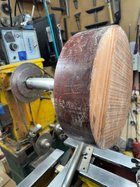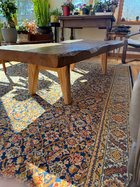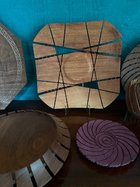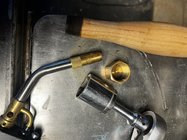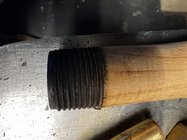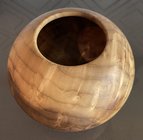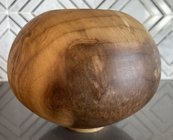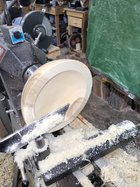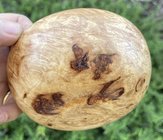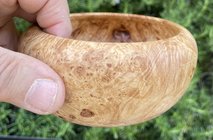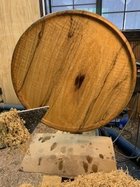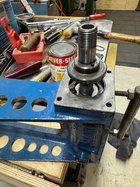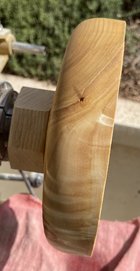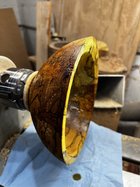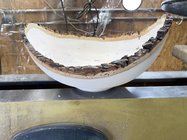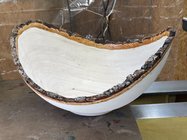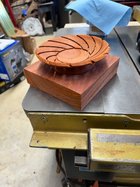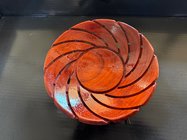-
December 2025 Turning Challenge: Single Tree! (click here for details) -
Congratulations to Bob Henrickson, People's Choice in the November 2025 Turning Challenge (click here for details) -
Congratulations to John Dillon for "Chinquapin Oak" being selected as Turning of the Week for December 22, 2025 (click here for details) -
Welcome new registering member. Your username must be your real First and Last name (for example: John Doe). "Screen names" and "handles" are not allowed and your registration will be deleted if you don't use your real name. Also, do not use all caps nor all lower case.
You are using an out of date browser. It may not display this or other websites correctly.
You should upgrade or use an alternative browser.
You should upgrade or use an alternative browser.
What’s on your lathe?
- Thread starter Rusty Nesmith
- Start date
Another Ribbon Sapele blank on the lathe for another Wedding present fruit bowl…
Took a break from turning to make new legs for an oak slab coffee table from a tree taken down in the early 1970’s…
And the finished sycamore sculptural piece…
Took a break from turning to make new legs for an oak slab coffee table from a tree taken down in the early 1970’s…
And the finished sycamore sculptural piece…
Attachments
Finishing up this chisel handle from a fellow turner that never got to it ! Added some stone too the voids
View attachment 61768View attachment 61769
Attachments
from a small piece of maple burl rough turned by Odie and given to me to finish. Rounded it out and undercut rim. Just took off lathe and one coat oil. Hoping some Odie turning magic rubs off on me.
Attachments
Odie
Panning for Montana gold, with Betsy, the mule!
I heated a fitting to thread it on the end and then turned on the lathe round and epoxied the 8mm square for carbide cutter in used it this morning !Finishing up this chisel handle from a fellow turner that never got to it ! Added some stone too the voids
View attachment 61768View attachment 61769
Attachments
Odie
Panning for Montana gold, with Betsy, the mule!
I have been able to improve questionable surfaces shear scraping and/or sanding after letting Danish oil dry on the piece. You may already do this.
I didn't on this one, but may return it to the lathe to give it another try. There's nothing to lose, because as it is, it's not anything more than a "give away". Thanks for the advice, Jim.....
-o-
Checking back with you, Jim.....
I re-turned the rim surfaces of the spalted maple burl bowl and to my amazement, it turned very well. The softness of the spalting was gone. Even though quite a bit of surface had to be removed, the spalting remained hard enough to attain a good sand-able result well below the original surface. The chunks that broke away are gone now. I left the interior as it was, because I was afraid the wall thickness would be too thin......but, that's not where the real problems were. It should have dawned on me to do this, because I'm well aware that the information on Watco D.O. clearly says that it penetrates and hardens.
Thanks for the inspiration to re-turn this bowl.....now, it's no longer a "reject".
Hopefully, this information will be of some useful help to a few other turners.
-o-
I never realized that it hardened like that. That’s great info.
Thanks,
Bob
Thanks,
Bob
Odie
Panning for Montana gold, with Betsy, the mule!
I never realized that it hardened like that. That’s great info.
Thanks,
Bob
I doubt that the D.O. will penetrate as much on many hardwoods as it did in this case, but the spalting absorbed it quickly on application, requiring multiple applications......indicating it was soaking up well below the surface. In this case, it worked perfectly!
In the future, and if I have a spalted bowl blank that will be problematic, it might be best to apply the D.O. after the first turn of a twice turned bowl.....after seasoning, and just prior to the second turn. I'll give that a try on a few questionable Hackberry bowls that are ready and waiting for the second turn.
-o-
Just a little chunk of spalted maple, 7.75x 3
I have also had success using DO in this manner, but it takes a long time to dry/cure. Something you might try - 5 min epoxy thinned 1:1 with acetone. The downside is the dangerous fumes - do it outside or with a lot of venting for an hour or so. It sets up in a few hrs due to the chemical reaction of the epoxy. It’s my answer for punky wood.it might be best to apply the D.O. after the first turn of a twice turned bowl.....after seasoning, and just prior to the second turn.
Odie
Panning for Montana gold, with Betsy, the mule!
Thanks Doug. I'll add that to the list of things that could be done. I have tossed out punky pieces in the past that might have been saved, as well as had other more successful attempts that didn't need anything. It is very difficult to analyze a bowl block, and decide beforehand if it needs help.....until you mount it and start lathe turning. Many of the bowl blocks I use, I only get to see photos of prior to purchasing, so that makes it that much more difficult to decide if it's worth it, or not.I have also had success using DO in this manner, but it takes a long time to dry/cure. Something you might try - 5 min epoxy thinned 1:1 with acetone. The downside is the dangerous fumes - do it outside or with a lot of venting for an hour or so. It sets up in a few hrs due to the chemical reaction of the epoxy. It’s my answer for punky wood.
This particular piece worked great with the D.O., and my plans are to experiment with it a little further the next time I have soft punky wood....
-o-
There's a guy on Youtube that takes very soft,punky wood and covers it with two part epoxy thinned with denatured alcohol. Seems to soak right in and harden up fine. I can grab a link if interested.Thanks Doug. I'll add that to the list of things that could be done. I have tossed out punky pieces in the past that might have been saved, as well as had other more successful attempts that didn't need anything. It is very difficult to analyze a bowl block, and decide beforehand if it needs help.....until you mount it and start lathe turning. Many of the bowl blocks I use, I only get to see photos of prior to purchasing, so that makes it that much more difficult to decide if it's worth it, or not.
This particular piece worked great with the D.O., and my plans are to experiment with it a little further the next time I have soft punky wood....
-o-
Odie
Panning for Montana gold, with Betsy, the mule!
Note:
I tried Minwax wood hardener, I believe about 20 years ago. My thoughts at that time, were that it didn't perform as well as I'd hoped, and subsequently tossed out the whole can when the contents went bad a few years ago. At the moment, I'm having trouble recalling the specific details of why I decided it wasn't working for me. Because I have made great improvements in my turning skills over the past couple decades, I don't completely trust what I may have thought twenty years ago, above what knowledge I have evolved to now.

Now if anyone else has used MWH with success, I'd be interested in hearing the details...
-o-
.
I tried Minwax wood hardener, I believe about 20 years ago. My thoughts at that time, were that it didn't perform as well as I'd hoped, and subsequently tossed out the whole can when the contents went bad a few years ago. At the moment, I'm having trouble recalling the specific details of why I decided it wasn't working for me. Because I have made great improvements in my turning skills over the past couple decades, I don't completely trust what I may have thought twenty years ago, above what knowledge I have evolved to now.

Now if anyone else has used MWH with success, I'd be interested in hearing the details...
-o-
.
Last edited:
I'm also interested in what people are using to harden punky, styrofoam-like spalted wood. I've got a bunch of spalted maple that's on the edge of too far gone, but perhaps I can use it for learning what works or doesn't. I did one piece with a 2-3 coats of sanding sealer, and got decent results. Hadn't thought of using DO, but that's worth a try. I've seen a reference to the Minwax wood hardener that Odie mentioned but haven't tried it yet.
At what point should any of the above be applied? Before the last cut, or after the last cut and before sanding?
At what point should any of the above be applied? Before the last cut, or after the last cut and before sanding?
I would start applying as you approach the final form.The styrofoam like wood tends to tear out deep so needs to be firmed up sooner than later. It may take several applications depending on how deep the finish penetrates.
Odie
Panning for Montana gold, with Betsy, the mule!
I'm also interested in what people are using to harden punky, styrofoam-like spalted wood. I've got a bunch of spalted maple that's on the edge of too far gone, but perhaps I can use it for learning what works or doesn't. I did one piece with a 2-3 coats of sanding sealer, and got decent results. Hadn't thought of using DO, but that's worth a try. I've seen a reference to the Minwax wood hardener that Odie mentioned but haven't tried it yet.
At what point should any of the above be applied? Before the last cut, or after the last cut and before sanding?
I would start applying as you approach the final form.The styrofoam like wood tends to tear out deep so needs to be firmed up sooner than later. It may take several applications depending on how deep the finish penetrates.
I think Gary has the right idea here. Applying DO (or any of the concoctions mentioned in this thread) just prior to reaching final form would be ideal. If you apply it directly to a roughed bowl, it may have to soak up to 1/2" to harden what will eventually become the depth of the final shape......and, that may be an "iffy" consideration.
-o-
Punky wood discussion - IMO if the wood is too far gone to get within 1/8”-1/4” of finished surface, it needs cactus juice or other true stabilization. These other concoctions are brushed on and only go so deep.
I used the mw hardener with very good results, and found it expensive. Its what led me to the epoxy-acetone stuff which seems to behave/feel like the mw stuff.
I used the mw hardener with very good results, and found it expensive. Its what led me to the epoxy-acetone stuff which seems to behave/feel like the mw stuff.
About a month ago I cut down a small red oak that was to close to the driveway and today I grabbed one piece that was about 5" diameter. The only thing I could think of to make with it was a thin walled goblet, which is something I haven't done for a long time. The 1st picture is after wet sanding the interior with 220 wet or dry paper. The second picture is the results of shear scrapping the outside to that point.


The 3rd picture shows the under cutting of the base, which is necessary so that the base can distort instead of a radial crack. Notice the healed over wound from when the driveway was put in 2004. The 4th picture is close to removing the piece from the waste block using a detail/spindle /shallow flute gouge. The final removal is done without stopping the lathe




The 3rd picture shows the under cutting of the base, which is necessary so that the base can distort instead of a radial crack. Notice the healed over wound from when the driveway was put in 2004. The 4th picture is close to removing the piece from the waste block using a detail/spindle /shallow flute gouge. The final removal is done without stopping the lathe


Odie
Panning for Montana gold, with Betsy, the mule!
Nothing fancy, but I bedazzled my lathe, replacing all the black plastic knobs with cherry. A while back, I was tightening my tailstock and the knob broke off, and the threaded part of the lever arm drove into my palm, chewing it up pretty good. The end of my hand modelling career. So that needed to be replaced, and the knob on one of my banjos has gone missing, so I did everything to match the headstock handle I did previously. It turned out to be WAY more satisfying to touch wood instead of plastic than I expected. I have 7/16 coupling nuts inside most pieces.



This is the finished goblet along with 5 of the tools used to turn it and the stub waste block that was left. The shear scrappers used on the inside and outside to refine the curves are not shown. The log on the left came from lower down on the tree and if you zoom in on it you can see why it would not be usable for a similar form.
The wound that was visible on the lower part of the cup and base in the turning photos corresponds with probably damage caused when the driveway was built about 20 years ago. The photo below shows a crack that occurred when I went a little too far with the shear scrapping.

Another round of Windsor chairs underway (comb back arm chair, fan back side chair, and fan back arm chair). The 12 legs are turned, as are the necessary stretchers. Still need to do back posts. The oak crests and arm rail are bent, oak spindles shaped with draw knife and spokeshave. A few more pieces to turnn then on to assembly.
Attachments
That is precise and very well turned Bob!! I'm impressed...Another round of Windsor chairs underway (comb back arm chair, fan back side chair, and fan back arm chair). The 12 legs are turned, as are the necessary stretchers. Still need to do back posts. The oak crests and arm rail are bent, oak spindles shaped with draw knife and spokeshave. A few more pieces to turnn then on to assembly.


